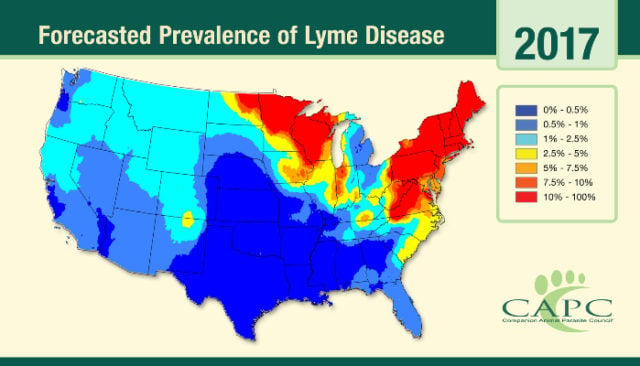
A new research developed a forecast map for Lyme disease in dogs to show where in the U.S. the infection is most likely to happen, with surprising results.
A study conducted at the University of Georgia has given veterinarians a forecast map of Lyme disease in dogs, which tells them which parts of the country have the most prevalence and risk of this disease for canines. This could help to better track, predict, and prevent Lyme disease in dogs as well as in humans.
The rapid increase of Lyme disease in the United States is a distressing issue, now more than ever. This new forecast map was created by Michael Yabsley (a parasitologist at the University of Georgia) and Christopher McMahan (assistant professor of mathematical sciences at Clemson University).
The Lyme disease map shows the percentage of dogs predicted to test positive for the infection in each county of the continental United States (48 states total). It was created by drawing on monthly test data from veterinarians, and provides the most up-to-date picture of Lyme disease presence by location.
Making the Map
The researchers used a combination of factors associated with Lyme disease (forestation, surface water area, population density, temperature, and median household income) along with almost 12 million Lyme disease test results collected from 2011-2015 in dogs (sorted by county). These results were provided by the IDEXX Lab diagnostics company.
Yabsley and McMahan hope to see this map used to optimize patient care by veterinarians, public health officials, and human physicians.
It was previously believed that the ticks carrying the disease-causing bacterium Borrelia burgdorferi were only contained in the northern United State. But recent research reveals that these ticks are now in half of the counties across the U.S., and are in the Southern States.
The states projected to be most heavily affected are all of the Northeast states from Pennsylvania up through Maine, as well as pockets of the Midwest, with nearly all of Wisconsin and Minnesota experiencing the highest rates.
How This Helps People
Because dogs get tested at their annual exams, this is the best method for detecting the prevalence of Lyme disease in any given area. This lends to heightening awareness in these areas, and can therefore help humans protect themselves against exposure.
Yabsley and McMahan are expanding upon this analysis to include additional information on the relationship between human and canine disease, and plan to release that later in the year.
This idea originated with CAPC, a nonprofit organization comprised of scientists who try to bridge the gap in understanding the prevalence of parasitic diseases. CAPC provides veterinarians the most up-to-date data on parasitic infections in pets.
Before now, veterinarians believed that Lyme disease was only endemic in the Northeastern and Mid-Central United States, and operated on this notion.
Now that they have a more clear understanding of where ticks are traveling and where Lyme disease is taking hold, they can work to better prevent its spread in the future.
How It All Works
Ticks live and feed all year round, and carry Lyme disease. They initially start feeding on mice, and then move into habitats close to our homes. Here, they find our dogs. Ticks are typically found in or near wooded areas, but when they travel on a host they can wind up anywhere.
Symptoms of Lyme disease generally appear between 5 and 30 days in humans, and 2 to 5 months in dogs. Symptoms tend to be flu-like in nature: fatigue, fever, reduced appetite, stiff muscles and painful joints. If diagnosed, Lyme disease can be treated (generally with antibiotics). If left undetected and untreated, it can cause long-term complications of the heart, muscles, and nervous system.
This research is intended to bring awareness to dog owners and veterinarians so that they can take the necessary steps toward preventing Lyme disease. Preventative methods include vaccinations and tick prevention medication.
Reference:
- Stella C. Watson, Yan Liu, Robert B. Lund, Jenna R. Gettings, Shila K. Nordone, Christopher S. McMahan, Michael J. Yabsley. A Bayesian spatio-temporal model for forecasting the prevalence of antibodies to Borrelia burgdorferi, causative agent of Lyme disease, in domestic dogs within the contiguous United States. PLOS ONE, 2017; 12 (5): e0174428 DOI: 10.1371/journal.pone.0174428












